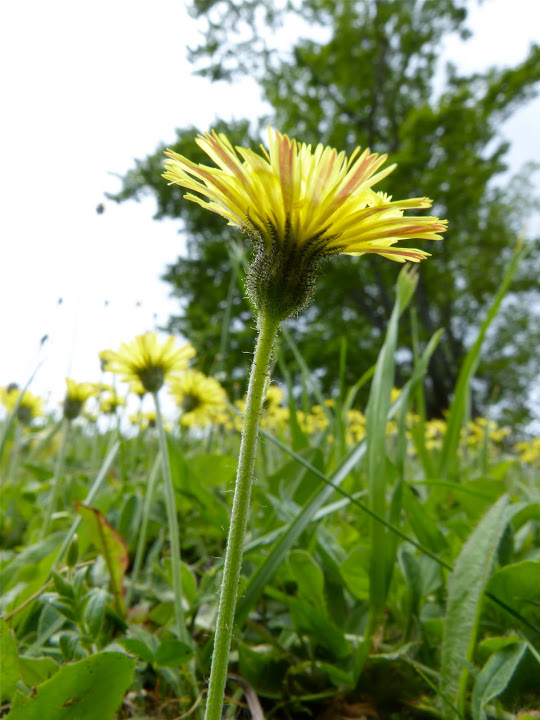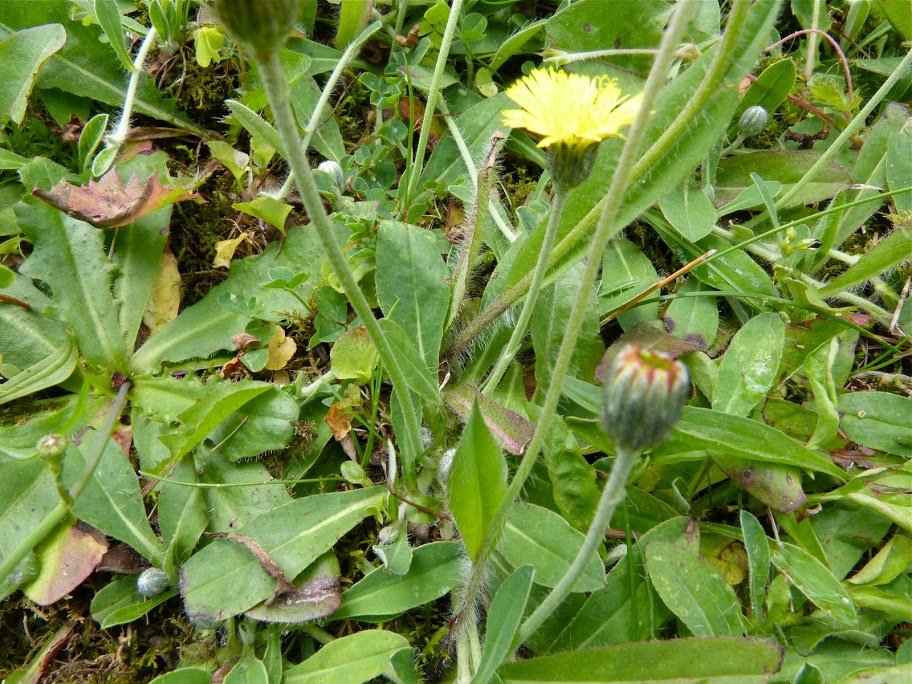Map Snapshot








14 Records
Seasonality Snapshot
Source: Wikipedia
| Pilosella officinarum | |
|---|---|

| |
| Scientific classification | |
| Kingdom: | Plantae |
| Clade: | Tracheophytes |
| Clade: | Angiosperms |
| Clade: | Eudicots |
| Clade: | Asterids |
| Order: | Asterales |
| Family: | Asteraceae |
| Genus: | Pilosella |
| Species: | P. officinarum
|
| Binomial name | |
| Pilosella officinarum Vaill.[1]
| |
| Synonyms[1] | |
| |
Pilosella officinarum (synonym Hieracium pilosella),[1] known as mouse-ear hawkweed,[2] is a yellow-flowered species of flowering plant in the daisy family Compositae (= Asteraceae), native to Europe and northern Asia. It produces single, lemon-coloured inflorescences. Like most hawkweed species, it is highly variable and is a member of a species complex of several dozens of subspecies and hundreds of varieties and forms. It is an allelopathic plant.
Description
[edit]It is a hispid (hairy) perennial plant, with a basal rosette of leaves. The whole plant, with the exception of the flower parts, is covered in glandular hairs, usually whitish, sometimes reddish on the stem. The rosette leaves are entire, acute to blunt, and range from 1–12 centimetres (0.39–4.72 in) long and 0.5–2 centimetres (0.20–0.79 in) broad. Their underside is tomentose (covered with hair). The flowering stem (scape) is generally between 5–50 centimetres (2.0–19.7 in) tall, and sprouts from the centre of the basal rosette. The flowerheads are borne singly on the scape and are a pale lemon-yellow colour, with the outermost ligules having a reddish underside. It flowers from May until August and the flowers are visited by various groups of insects, especially flies.[3]
The plant favours dry, sunny areas. It grows well on sandy and similarly less fertile ground types. It produces stolons which generate a new rosette at their extremity, each rosette has the possibility of developing into a new clone forming dense mats in open space. It also propagates by seeds.
Ecology
[edit]It is a known allelopathic plant, whose roots secrete several substances inhibiting root growth,[4] including its own. It can be controlled through rotation with clover and grasses where possible.[4]
Recent research claims that Pilosella officinarum exhibits an atavism by the reemergence of sexual reproduction.[5]
The plant has been found as an invasive species in Sphagnum peatlands disturbed by peat extraction in southern Patagonia.[6]
Similar species
[edit]Shetland mouse-ear hawkweed (Pilosella flagellaris subsp. bicapitata) is similar, but has two flowers per leaf stalk. It is found in the Shetland Islands only, on rocky coastal grassland. It flowers from May to August.[7]
Cultivation and uses
[edit]Mouse-ear hawkweed has become a common introduced invasive species in North America (where it is found in southern Canada and both north-east and north-west United States), and New Zealand. It is a level C noxious weed in the United States (with higher levels in the states of Washington and Oregon), and a weed in Quebec. It does not have special designations in other locations in Canada. It is known to be strongly invasive in New Zealand's tussock fields, where there are no native species of hawkweed, and biological control measures are being undertaken to control it and other similar species. In Victoria and NSW, Australia, Hawkweed Sp. are declared as State Prohibited Weeds and are controlled under The Bio Security Act 2015. Currently there are several eradication programs operating (often employing volunteers) to locate, prevent the spread of and eradicate any Pilosella (Hieracium) sp. plants.
Joseph Pitton de Tournefort mentions that blades covered in this plant's juices were believed to cut through stone as easily as through wood.[8]
Phytochemistry
[edit]The mouse-ear hawkweed contains umbelliferone, a compound similar to coumarin.[9] The plant produces triterpenoids, mainly taraxasterol, but also the 4,4-dimethyl phytosterols alpha- and beta-amyrin, taraxerol, and fern-7en-3beta-ol.[10] It has been used in folk medicine,[11] and recreationally as a cannabis substitute.[12][13]
Image gallery
[edit]References
[edit]- ^ a b c "Pilosella officinarum Vaill.". Plants of the World Online. Royal Botanic Gardens, Kew. Retrieved 2019-01-29.
- ^ USDA, NRCS (n.d.). "Hieracium pilosella". The PLANTS Database (plants.usda.gov). Greensboro, North Carolina: National Plant Data Team. Retrieved 31 January 2016.
- ^ Van Der Kooi, C. J.; Pen, I.; Staal, M.; Stavenga, D. G.; Elzenga, J. T. M. (2015). "Competition for pollinators and intra-communal spectral dissimilarity of flowers". Plant Biology. 18 (1): 56–62. doi:10.1111/plb.12328. PMID 25754608.
- ^ a b Carol Piening (1988-08-29). "Element Stewardship Abstract for Hieracium Pilosella". The Global Invasive Species Initiative. Archived from the original on 2006-09-18. Retrieved 2006-11-17.
- ^ Science News, vol. 171, p. 302
- ^ Domínguez, Erwin; Bahamonde, Nelson; Muñoz-Escobar, Christian. "Efectos de la extracción de turba sobre la composición y estructura de una turbera de Sphagnum explotada y abandonada hace 20 años, Chile" [Effects of peat extraction on the structure and composition of Sphagnum peatland exploited and abandones for 20 years, Chile]. Anales del Instituto de la Patagonia (in Spanish). 40 (2): 37–45.
- ^ Rose, Francis (2006). The Wild Flower Key. Frederick Warne & Co. pp. 480–481. ISBN 978-0-7232-5175-0.
- ^ Hieracium pilosella in the online Flore Laurentienne
- ^ Bishop, G. F.; A. J. Davy (1994). "Hieracium pilosella L. (Pilosella officinarum F. Schultz & Schultz-Bip.)". Journal of Ecology. 82 (1): 195–210. doi:10.2307/2261400. JSTOR 2261400.
- ^ Gawrońska-Grzywacz, Monika; Krzaczek, Tadeusz (2007-03-01). "Identification and determination of triterpenoids in Hieracium pilosella L." Journal of Separation Science. 30 (5): 746–750. doi:10.1002/jssc.200600253. PMID 17461116.
- ^ Willer, Johanna; Zidorn, Christian; Juan-Vicedo, Jorge (2021-12-05). "Ethnopharmacology, phytochemistry, and bioactivities of Hieracium L. and Pilosella Hill (Cichorieae, Asteraceae) species". Journal of Ethnopharmacology. 281: 114465. doi:10.1016/j.jep.2021.114465. hdl:20.500.12466/3283. ISSN 0378-8741. PMID 34358652.
- ^ "Hieracium Sp. - Hawkweed". eflora.neocities.org. Retrieved 2023-01-16.
- ^ Berger (2019-12-20). "Habichtskraut - ein wildwachsender Cannabis-Ersatz". Lucys Rausch (in German). Retrieved 2023-01-16.
External links
[edit] Media related to Pilosella officinarum at Wikimedia Commons
Media related to Pilosella officinarum at Wikimedia Commons





